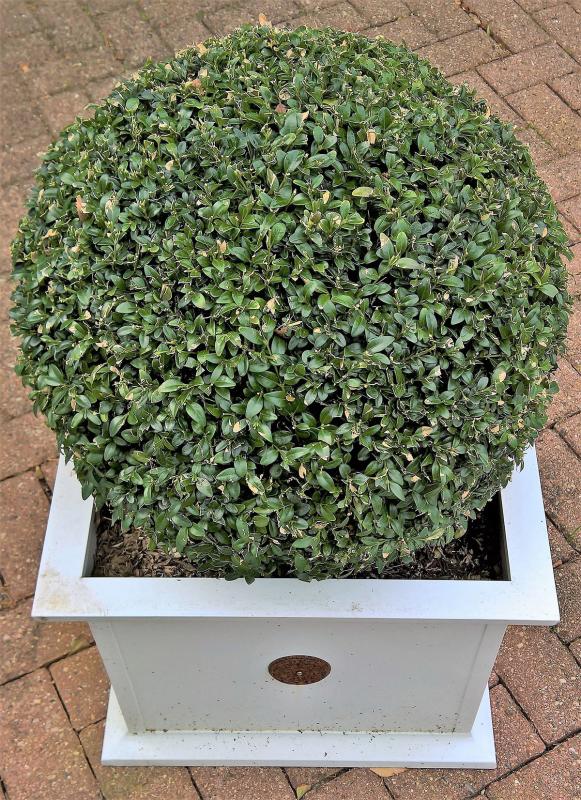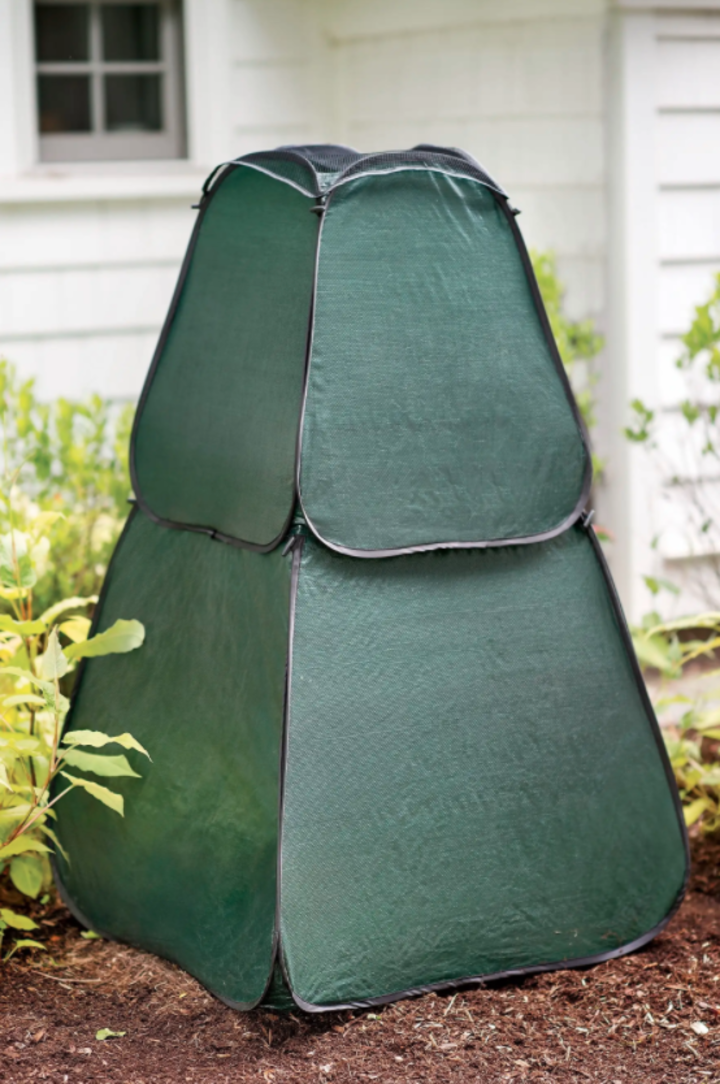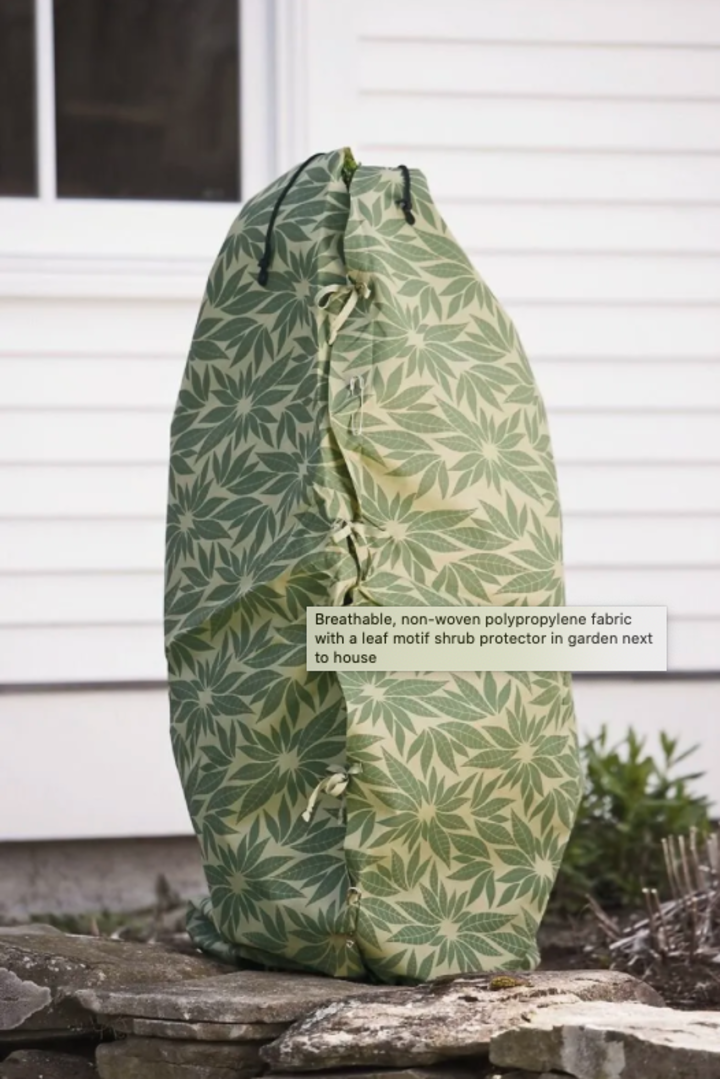Sarah Browning, Nebraska Extension Educator

Many homes have patios and decks complete with large pots containing shrubs or trees. These containers provide a feeling of permanence and beauty to the area. We see pictures in garden magazines of beautiful winter containers with boxwood, yew, arborvitae or holly in southern gardens. But unfortunately, containerized plants usually die during Nebraska winters if not provided with good winter protection.
What Causes Winter Damage?
In containers, the roots of plants are exposed to below-freezing temperatures on all sides. Containers lack the temperature buffering and insulating effect soil provides to plant roots in ground plantings. Winter soil temperature inside an above-ground container can be very close to air temperature, meaning the soil can freeze solid and your plant roots along with it. This will kill your plants.
Frost heaving is another concern. As temperatures fluctuate, the soil thaws and refreezes causing the plant to heave out of the soil. This tears the roots and can expose the roots to drying winds. Branches can be broken directly by strong winds or by the container tipping over.
Finally, sudden temperature changes can also damage the container itself causing it to crack., especially clay and ceramic containers.

Providing Winter Protection
Small plants can easily be moved into a cool garage or basement. Temperatures should be in the upper 30's or lower 40's, but not below freezing. Woody evergreen plants do need sunlight and all plants require periodic watering. Check the soil as you would in summer and water when it gets dry.
Protecting large plants is a bigger challenge but it can be done. Covering the plant and the container thoroughly can help protect the plant. However, if the plant is too tender for our climate or if the winter is unusually harsh, even these measures may not be adequate.
To aid in the success of the plant, select plants hardy for our area and make every effort to be sure the plant is going into the winter in a healthy state. Continue watering the plant through the fall. Do not fertilize after mid-summer. Woody plants should be encouraged to gradually cease growth and harden off in preparation for winter.

Wrapping an Outdoor Container
After the first hard frost, when the plant has lost most of its leaves, begin the process of winter protection. Gently tie together the branches so they won't be damaged when you pack insulating material around them. Water the tree thoroughly and mulch the top of the soil with several inches of straw or leaves.
Next, make a cylinder around the outside of the container with chicken wire or other type of garden fencing. Make the cage tall enough to enclose the entire plant, down to the base of the container - remember, you need to protect the roots, too. Fasten the wire fencing to a stake with wire or zip-ties for added support. Fill the cage with straw or leaves working carefully so no branches are broken in the process.
Finally, wrap the outside of the cage with burlap or shade cloth and secure it with twine. This prevents the stuffing material from blowing away. As a last step, cover the cage with plastic or roofing paper and tuck in the edges. Tie over the top to prevent it from blowing off.
Leave yourself a way to check soil moisture throughout winter. You'll need to water whenever the soil is dry to prevent plant desiccation.
When spring arrives, unwrap the tree gradually. Remove the plastic or roofing paper cover first. Gently pull out the leaves or straw from around the branches and untie them. The stuffing can be used as a garden mulch around perennial flowers or in the vegetable garden. Leave the fencing and the outside wrap in place. Water if the soil is dry.
Once the danger of late spring freeze is past, remove the burlap or shade cloth wrap and the cage. Prune broken or damaged branches and remove any other unnecessary growth. Select a cloudy day to remove coverings so the tree can acclimate gradually.
Store the fencing and burlap away for next year. Containerized trees and shrubs add a great deal to our landscapes. With proper winter protection, the same plant can provide beauty for many years.
New products in the garden market make winter protection a little easier. Gardeners Supply, gardeners.com, now offers a Pop-up Plant Protector or Shrub Jacket. Both can be used for multiple years and stuffed with leaves or straw to provide the extra winter protection container plants need to survive. Similar products are available from other companies, also. Just make sure the outer covering material is thick enough to offer a good level of temperature protection.
"Planting" An Outdoor Container
Another good method of winter protection is to bury the decorative container in the ground. This method takes advantage of soil's temperature buffering abilities to protect your plant.
In fall before the soil freezes, dig a hole large enough to accommodate the entire container all the way to the upper lip. When daytime temperatures drop into the 30s, place the container in the soil and backfill around the edges with more soil. Apply a thick 6-12 inch layer of wood chips, leaves or straw over the soil surface of the container and the surrounding area. If winter conditions are dry, periodically check soil moisture in the container and water as needed. In spring, the container can be lifted from the soil, washed and returned to its location for another summer.
If in-ground winter protection is used every year, the process can be simplified by permanently installing another container in the soil large enough to accommodate the decorative container. Use an inexpensive black plastic pot. Bury it in the soil, then in fall the decorative container can be placed inside; backfill and filled around the edges with straw, hay or wood chips. Cover the container surface with a thick 6-12 inch layer of insulating material as described above.
Grouping Containers
Finally, if you have many containers to protect, another option is grouping them together in a protected location. Place smaller containers in the middle with large containers around the outside edges. Make sure all the plants are well watered, then cover them with a thick layer of wood chips, straw, hay or leaves. A "fence" of straw bales creates a nice barrier, providing both temperature protection and providing a way to keep wood chips around the containers, but you can also use chicken wire mesh and stakes or simply create a free-standing mulch pile with the containers buried in the center. Make sure the mulch layer is 6-12 inches deep over the lip of the containers.
In spring, gradually remove the mulch, enabling the plants to acclimate to spring weather conditions.
Reference to commercial products or trade names is made with the understanding that no discrimination is intended and no endorsement by Nebraska Extension is implied. Use of commercial and trade names does not imply approval or constitute endorsement by Nebraska Extension. Nor does it imply discrimination against other similar products.
Images:
- Boxwood in container. Pixabay.com
- Pop up plant protector, Gardeners Supply, gardeners.com
- Shrub jacket protector, Gardeners Supply, gardeners.com